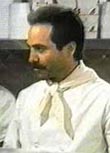This is the procedure we used to follow to genreally check lamps and power supplies....
------------------------------------------
Before beginning, quickly verify that the power supply is operating at or below the AMPERAGE shown on the power supply nameplate.1. With a small flat head screwdriver, "zero" the volt meter and ammeter (if analog type).
2.Place the auto-ignition switch to "MANUAL".
3. Open the lamphouse door and defeat the door interlock safety switch.
4.Observing proper polarity, connect a calibrated volt meter to the DC power cables.
5.Power on the lamphouse. The bulb should not ignite while the auto-ignition switch is in "MANUAL".
6. Compare the voltage reading from each volt meter. Record the values. Replace the meter in the lamphouse if the values are more then 15% apart from the calibrated volt meter.
Remove the volt meter leads.
7. Press the "STRIKE" button to ignite the lamp OR: If there is no "STRIKE" button:
Flip the auto-ignition switch to "AUTO", then immediately return it to "MANUAL" after the bulb is lit.
Caution: The auto-igniter must be disabled. If the bulb should go out, it can not be allowed to re-ignite automatically and injure someone connecting leads or damage test equipment.
8. Connect the oscilloscope across the ammeter shunt. Set the oscilloscope to 10 millivolts per division; the timebase to 20 milliseconds per division. Avoid using "X10" probes. There are no special triggering requirements, AC or "AUTO" will work.
Note: Since the oscilloscope will be reading DC, greater accuracy can be obtained by adjusting the scope's baseline to the bottom of the screen, rather then to the center.
Caution: Older oscilloscopes with a "third-wire" ground on the power cord may give erratic or incorrect readings. This may be caused when the shield wire of the oscilloscope probe is connected to one side of the shunt. (Effectivly, one side of the DC output is being grounded when the probe shield in connected.) A solution is to isolate the "third-wire" ground on the oscilloscope using a grounding adapter, but this can create an unsafe condition. If you do this, be aware you are working with ungrounded equipment and act accordingly.
Record Imax (total peak voltage) Record Imin (minimum peak voltage) Calculate ripple and record. The percentage of ripple should be less then 5%.
ripple = {Imax - Imin} over Imax times 100%
9. Record the lamphouse ammeter value.
Because the ammeter shunt reduces the actual current value to the lamphouse ammeter by 1/3000, there will be 3 amps for every 1 millivolt shown on the oscilloscope. Therefore, the amperage can be calculated by multiplying Imax, in millivolts, times 3000. For example:
36 mv * 3000 = 108 amps
Note that this test requires an accurate 150 mv shunt.
10.Compare the readings from the ammeter and the calculated current. Record the values. Replace the meter in the lamphouse if the values are more then 15% apart.
11.Return the door safety interlock switch to normal.
The following information should have been recorded:
The date of testing.
The lamphouse model, serial number, and location.
The power supply model and serial number.
The values: Imax; Imin; operating lamphouse voltage; actual voltage; operating amperage; actual amperage; percentage of ripple.

 Home
Home
 Products
Products
 Store
Store
 Forum
Forum
 Warehouse
Warehouse
 Contact Us
Contact Us




 Printer-friendly view of this topic
Printer-friendly view of this topic
















